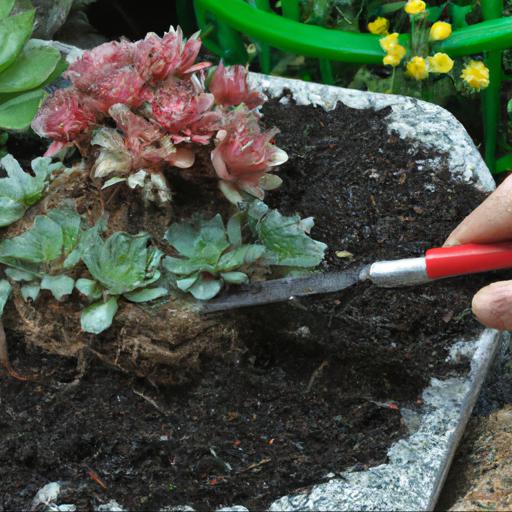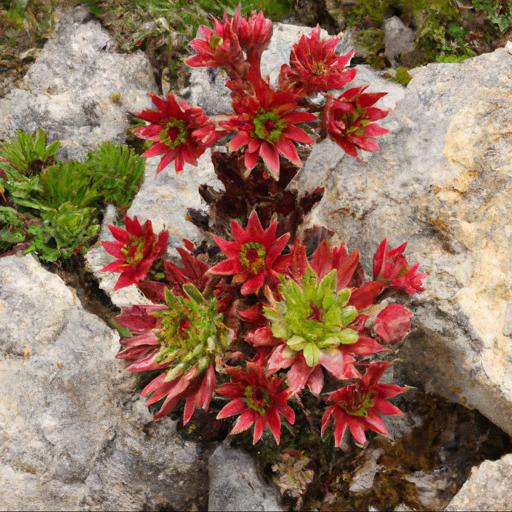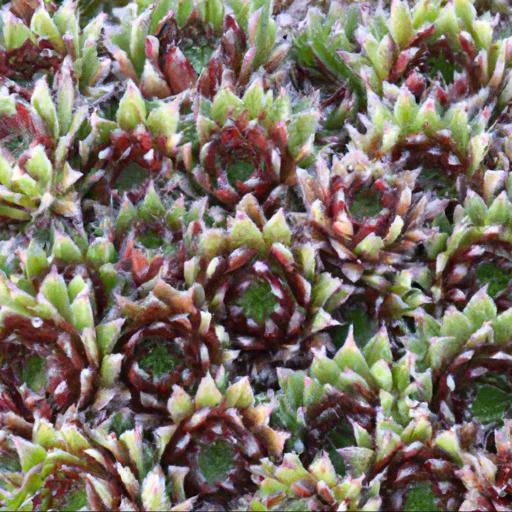Sempervivum calcareum, commonly known as “Hen and Chicks” or “Houseleeks” is a succulent perennial plant native to the mountainous regions of Europe. It is an evergreen plant with thick, fleshy leaves and rosettes of star-shaped flowers that bloom in the summer. The plant is drought-tolerant and can survive in a variety of conditions, making it a popular choice for gardeners and landscapers alike.
It is also a popular choice for rock gardens and terrariums. Sempervivum calcareum is a low-maintenance plant that requires minimal care and is easy to propagate.
Its striking appearance and hardiness make it a great choice for any garden.
Growing and caring for sempervivum calcareum

If you want to enjoy evergreen succulent beauty in your garden, Sempervivum calcareum is definitely the right choice. Famous as Hen and Chicks, this variety of succulent requires little effort but rewards you with gorgeous foliage and colorful blooms. Native to the northern Mediterranean, Sempervivum calcareum produces rosettes of fleshy, blue-green leaves that come in a variety of shapes.
Its waxy coating works as a perfect defense against drought and the hot summer sun. It is also resistant to pests and diseases, making it a great choice for both beginner and experienced gardeners alike.
Caring for Sempervivum calcareum is quite simple. Growing best in well-drained soil or containers, these succulents don’t need much watering.
Most varieties are drought-tolerant and can survive without water for weeks at a time. The only time they need water is if the soil is dry and the leaves start to droop. When it comes to fertilizing, they can thrive with one application of fertilizer approximately every two months.
Sempervivum calcareum is also easy to propagate. The best way to do it is by division.
Each rosette produces offsets and simply plucking them off with your fingers and planting them in a new pot will make them grow into new plants. And when temperatures dip in the winter months, this succulent will go dormant, saving you the trouble of frequent care. Overall, Sempervivum calcareum is a great succulent for any garden.
With its incredible foliage, vibrant blooms, and low maintenance requirements, it is sure to bring life and color to your garden with minimal effort from your side.
Benefits of sempervivum calcareum

The Sempervivum calcareum is a unique and hardy plant that thrives in harsh conditions, making it an ideal choice for many gardeners. Its low maintenance and delicate evergreen foliage make it stand out from the rest of the species, while it’s easy to propagate nature makes it highly versatile in the garden.
This species of Sempervivum, also known as ‘Black Hens and Chicks’, is native to Europe and can tolerate temperatures even below zero. It can stand a lot of sun and also withstand a bit of drought, but make sure to water it regularly if you live in an arid climate. Its succulent foliage helps it conserve water, making it ideal for container gardening as it doesn’t require frequent watering.
From its simple rosette structure to its small pink flowers, this species is one of the easiest to identify from the family of Sempervivum. The Sempervivum calcareum is native to chalky soil and can use its roots to store calcium and magnesium for better growth. This plant is a drought resistant and can survive in average to poor soil in sunny and arid conditions.
It also requires very little fertilizer, meaning it’s a cost-effective addition to every garden with its minimal maintenance. Whether planted in borders, rockeries or pathways, containers or green roofs, this bright, vibrant and evergreen addition works wonderfully in any garden setting, reminding us of its resilience and standing testament to its ability to open up our minds and marvel at its eternal beauty.
Common problems with sempervivum calcareum

Sempervivum calcareum, or commonly referred to as “hens and chicks”, is a small, mat-forming, succulent plant which is native to the mountains of the Mediterranean region. It is very popular in gardens due to its ability to adapt to a variety of conditions, and its low maintenance needs. However, as with any plant, Sempervivum calcareum can suffer from a variety of problems.
Some common problems include over or underwatering, lack of sunlight, poor drainage, under or over-fertilizing, and lack of air circulation. All of these conditions can cause the plant to experience yellowing, stunted growth, and ultimately, death.
To prevent these issues with Sempervivum calcareum, it is important to ensure that the soil is well-draining, in a sunny location and suitable for the species. Overwatering should be avoided and the fertiliser needs to be monitored to ensure that the plant receives the correct amount for its needs.
Furthermore, it is also important to ensure that the roots are well-aerated, and that no pests or diseases become an issue with the plant. Taking the necessary steps to ensure the success of your Sempervivum calcareum is essential to having a healthy, well-looking plant in your garden. With the right soil and care, this small, mat-forming succulent will thrive and flourish in your garden.
How to propagate sempervivum calcareum
Ready to add a fun, low-maintenance plant to your garden? Sempervivum calcareum, also known as the Provence houseleek, is a flowering species of succulent that’s perfect for outdoor gardens and window boxes alike. If you’re interested in propagating more of the Provence houseleek variety, then this guide is for you.
The key to propagating sempervivum calcareum is patience. Unlike traditional garden plants, sempervivum don’t need regular waterings or nutrient-rich soil to propagate.
This gives them a certain level of hardiness, making them ideal for a busy gardener. A simple yet effective way to propagate your sempervivum calcareum is to use the ‘nodules’. Nodules are small, tightly-knit groups of the succulent leaves, which easily detach from the central stem of the plant.
Each nodule is a single unit of growth, which can be transplanted into your garden. If you’d like to propagate sempervivum calcareum from seed, the process is relatively straightforward.
To get started, ensure that you have a well-draining potting mix. Place a few seeds in each pot, covering them with a thin layer of soil. Ask your local gardening centre for recommended seed germination temperatures, and be sure to check your plants regularly for signs of growth.
Ultimately, propagating sempervivum calcareum is a straightforward and low-maintenance endeavour. Patience is key, but with a bit of effort and the right conditions, you’ll be able to bring more of these bright and beautiful succulents into your garden.
Conclusion
Sempervivum calcareum is a species of flowering succulent plant native to the mountains of Europe. It has a rosette form and is known for its ability to thrive in harsh, rocky environments.
The leaves of the plant are a silvery-green color and its flowers are a deep red. This hardy species is popular among gardeners for its ability to tolerate drought and poor soil conditions. It is also a great choice for rock gardens and containers.
FAQ
What is the scientific name of Sempervivum calcareum?
The scientific name of Sempervivum calcareum is Sempervivum calcareum L.
Where is Sempervivum calcareum typically found?
Sempervivum calcareum is typically found in rocky limestone habitats in the mountains of Central and Southern Europe.
What type of soil does Sempervivum calcareum prefer?
Sempervivum calcareum prefers well-draining, sandy, alkaline soil.
What are the characteristics of Sempervivum calcareum?
Sempervivum calcareum is a succulent perennial plant that is native to the Mediterranean region. It has thick, fleshy, gray-green leaves and produces star-shaped pink flowers in the summer. It is drought tolerant and prefers well-drained soil. It is also very hardy and can tolerate temperatures as low as -20°F.
How often should Sempervivum calcareum be watered?
Sempervivum calcareum should be watered about once a week, or when the soil is dry to the touch.
What are the benefits of growing Sempervivum calcareum?
The benefits of growing Sempervivum calcareum include its drought-tolerance, low-maintenance requirements, and ability to thrive in rocky, sandy, and well-drained soils. It is also a great choice for rock gardens and container gardens, as it is a low-growing, evergreen succulent with attractive foliage.

